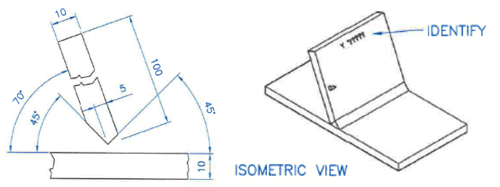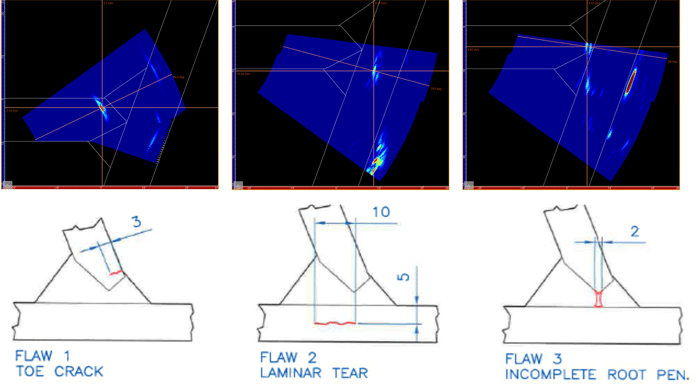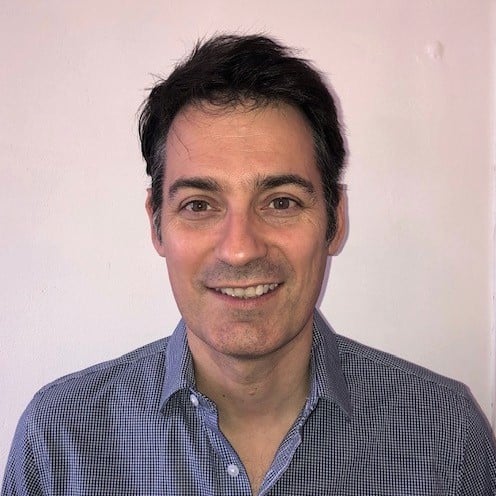TKY joints are widely used in different construction sectors, storage tanks, naval components, bridges, and more. A failure in a fillet weld may lead to heavy loss or wastage of materials contained by a tank, or it may have other major consequences to the fitness-for-purpose of assets. T-joints and similar weld geometries have always presented a challenge for ultrasonic testing, but there is now a way to validate that coverage is adequate and reduce the adverse effects of this configuration.
Traditionally, ultrasonic testing (UT) of fillet welds has always been possible, but somewhat impractical due to the geometry of the joint. While Standards give guidance on how to perform a proper scan plan, achieving complete coverage can sometimes be problematic. Undesirable (repetitive) echoes coming from various places of the joint make analysis complicated and tedious. This leads to lower efficiency, and unfortunately, a lower Probability of Detection (PoD).
A complete software tool exists in Capture™ allowing for the definition of T&Y joints. It is now easy to calculate the optimum scan plan directly on the equipment to guarantee complete coverage of the welds. Cross-section overlays are calculated and superimposed with the ultrasonic data making it possible to precisely position and size indications. It is also possible to account for rebounds off the various surfaces of the joints.
To illustrate this, we are using a 70° Y-joint with double fillet and a bevel preparation on each side. This mock-up contains three defects: toe crack, lamellar tear and incomplete penetration.

The following video shows how to easily setup this Y-joint in Capture. A parametric definition of the weld with few values allows for a quick and realistic definition of the component.
Standards provide some guidance on how to realize the proper scan plan to inspect T&Y joints. When access permits, the preferred technique is from the plate opposite the web using a combination of 0° linear scan and sectorial scans perpendicular to the bevels. Unfortunately, accessibility is sometimes an issue and operators might have to inspect the joints from other surfaces. Capture allows operators to position their probe on any surface of the joint and calculate scan plans with any type of probes (linear, matrix, DLA, DMA). By selecting the correct index offset and the proper delay laws, operators can make sure to fully cover the weld. When using focusing, it is possible to optimize the position of the focusing points and thus optimize the sensitivity of detection of indications positioned along the bevels. Sectoral or linear scans are displayed in real-time and superimposed on the 3D component to evaluate the effectiveness of the delay laws allowing the operator to modify them on the fly and properly adjust the angles and focusing parameters.
During acquisition and analysis, operators have access to a cross-section overlay of the joint. Sectorial and/or linear scans are superimposed taking into account rebounds off the various surfaces of the joint. This helps operators precisely position any indications and distinguish between geometry echoes and echoes coming from defects. The following video shows the data acquisition and analysis of the fillet weld described before.
By adjusting the Gates and using a combination of the different views such as S-scan, C-scan, D-scan, Side and Top views, it is possible to analyze the joint and identify and size the various defects. We use the new Auto-sizing feature to size the various indications in this joint. The 3D data export also shows all the data in the 3D of the component.
The following images show sectorial scan screenshots for the three defects.

Eddyfi Technologies proposes a unique solution for the ultrasonic inspection of TY joints commonly found in the oil and gas, metallurgy, and marine industries. Our solution helps operators simplify inspections and save time.
Contact us to discuss your specific inspection requirements. Not ready to chat? Check out our Eddyfi on Demand platform filled with webinars, how-to videos technical papers and training courses through the Eddyfi Academy (access the latest FREE e-learning on Capture here). Finally, we invite you to subscribe to our quarterly newsletter and stay Beyond Current.





